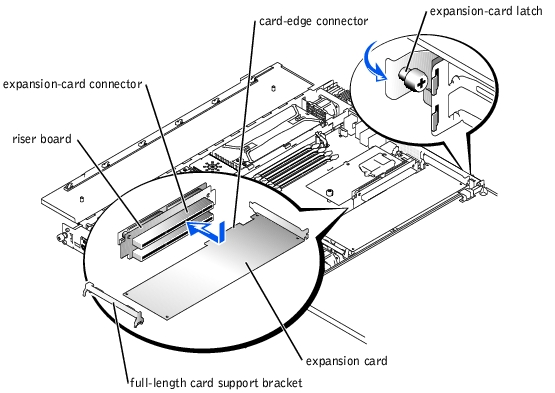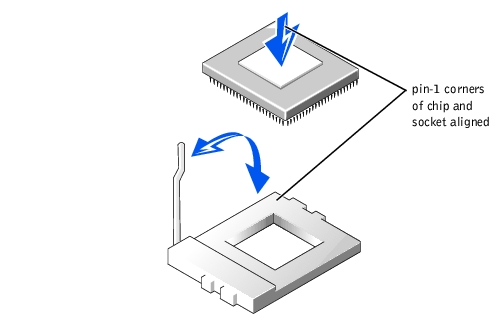 Installing Expansion Cards
Installing Expansion CardsDell™ PowerEdge™ 1650 Systems Installation and Troubleshooting Guide
This section describes how to install expansion cards, memory modules, a microprocessor, or a ROMB card. This section also includes instructions for replacing the system battery. Use Figure 6-1 to locate the system board features. Table 6-1 describes the system board connectors and sockets.
|
Connector or Socket |
Description |
|---|---|
BACKPLANE | SCSI backplane board connector |
BANKn_DIMM_x | Memory module sockets |
BATTERY | System battery connector |
CDROM | CD drive connector |
EMBEDDED_REMOTE_ | Connector for optional server management card (when available) |
ERA_NIC | server management port connector (when available) |
ETHERNET_USBn | USB (top) and NIC connectors |
FANn | Cooling fan power connectors |
FLOPPY | Diskette drive connector |
FRONT PANEL | System control panel connector |
IDE | IDE drive connector |
IDE_POWER | IDE drive power connector |
KYBD_MOUSE | Mouse (top) and keyboard connectors |
POWER | Power connector |
PROCESSOR n | Microprocessor sockets |
RAID | Socket for optional ROMB card |
REAR_ID | cable management arm system status connector |
RISER | PCI riser board connector |
SCSI_B | External SCSI connector |
NOTE: For the full name of an abbreviation or acronym used in this table, see "Abbreviations and Acronyms." | |
Figure 6-1. System Board Connectors and Sockets

Expansion cards are installed on the system's riser board (see Figure 6-2). The riser board plugs into the RISER connector on the system board (see Figure 6-1) and is considered an extension of the system board.
Your system is available with two different riser board configurations (see Figure 6-2):
You can install only half-length PCI cards in the lower expansion slot (PCI2). You can install a full-length expansion card in the upper expansion slot (PCI1) unless you have installed an optional server management card. In this case, neither slot will accommodate full-length cards.
Figure 6-2. Riser-Board Expansion-Card Connectors

To install an expansion card, perform the following steps.

|
CAUTION: Before you perform this procedure, you must turn off the system and disconnect it from its power source. For more information, see "Safety First—For You and Your System" in "Troubleshooting Your System." |
See the documentation that came with the expansion card for information on configuring the card, making internal connections, or otherwise customizing the card for your system.
Figure 6-3. Installing an Expansion Card

If the card is a full-length card, you may need to guide the front edge of the card into the full-length card support bracket (see Figure 6-3).
See the documentation supplied with the card for information about its cable connections.
To remove an expansion card, perform the following steps.

|
CAUTION: Before you perform this procedure, you must turn off the system and disconnect it from its power source. For more information, see "Safety First—For You and Your System" in "Troubleshooting Your System." |
 |
NOTE: Installing a filler bracket over an empty expansion slot is necessary to maintain Federal Communications Commission (FCC) certification of the system. The brackets also keep dust and dirt out of the system and aid in proper cooling and airflow inside the system. |
The four memory module sockets on the system board (see Figure 6-1) can accommodate from 256 MB to 4 GB of registered synchronous dynamic random-access memory (SDRAM).
The system is upgradable to 4 GB by installing combinations of 128-, 256-, 512-MB, or 1-GB registered memory modules. You can purchase memory upgrade kits as needed.
 |
NOTE: The memory modules must be PC-133 compliant. |
Starting with the socket farthest from the system power supply bay, the memory module sockets are labeled BANK1_DIMM_A, BANK1_DIMM_B, BANK2_DIMM_A, and BANK2_DIMM_B (see Figure 6-4). When you install memory modules, follow these guidelines:
Figure 6-4. Memory Module Sockets

Table 6-2 illustrates several sample memory configurations based on these guidelines.
|
|
BANK1 |
BANK2 | ||
|---|---|---|---|---|
|
Total Desired Memory |
DIMM_A |
DIMM_B |
DIMM_A |
DIMM_B |
256 MB | 128 MB | 128 MB | none | none |
512 MB | 256 MB | 256 MB | none | none |
1 GB | 256 MB | 256 MB | 256 MB | 256 MB |
4 GB | 1 GB | 1 GB | 1 GB | 1 GB |
To perform a memory upgrade to the system board, perform the following steps.

|
CAUTION: Before you perform this procedure, you must turn off the system and disconnect it from its power source. For more information, see "Safety First—For You and Your System" in "Troubleshooting Your System." |
Figure 6-1 shows the general location of the memory module sockets on the system board. Figure 6-4 shows the order of the memory module sockets.
After the system completes the POST routine, it runs a memory test. The system detects that the new memory does not match the system configuration information and displays an error message.
The system should have already changed the value in the System Memory setting to reflect the newly installed memory.
To install a memory module, perform the following steps:
Figure 6-5. Installing a Memory Module

The memory module socket has two alignment keys that allow the memory module to be installed in the socket in only one way.
When the memory module is properly seated in the socket, the ejectors on the memory module socket should align with the ejectors on the other sockets with memory modules installed.
To remove a memory module, press down and outward on the ejectors on each end of the socket until the memory module pops out of the socket (see Figure 6-6).
Figure 6-6. Removing a Memory Module

To take advantage of future options in speed and functionality, you can add a second microprocessor or replace either the primary or secondary microprocessor.
 |
NOTICE: The second microprocessor must be of the same type and speed as the first microprocessor. |
Each microprocessor and its associated level 2 (L2) cache memory are contained in a FC-PGA2 package that is installed in a ZIF socket on the system board. The following subsection describes how to install or replace the microprocessor in either the primary or secondary microprocessor connector.
In addition to the ZIF socket for the primary microprocessor on the system board, there is a second ZIF socket to accommodate a secondary microprocessor. The secondary microprocessor must have the same operating frequency and cache size as the primary microprocessor.
The following items are included in the microprocessor upgrade kit:

|
CAUTION: Before you perform this procedure, you must turn off the system and disconnect it from its electrical outlet. For more information, see "Safety First— For You and Your System" in "Checking Inside the System." |
 |
NOTICE: Never remove the heat sink from a microprocessor unless you intend to remove the microprocessor. The heat sink is necessary to maintain proper thermal conditions. |

|
CAUTION: The microprocessor chip and heat sink can become extremely hot. Be sure that the microprocessor has had sufficient time to cool before handling. |

 |
NOTICE: Be careful not to bend any of the pins when removing the microprocessor chip. Bending the pins can permanently damage the microprocessor chip. |
Leave the release lever up so that the socket is ready for the new microprocessor.
Figure 6-8. Removing the Microprocessor

 |
NOTICE: Be careful not to bend any of the pins when unpacking the microprocessor chip. Bending the pins can permanently damage the microprocessor chip. |
If any of the pins on the microprocessor appear bent, see "Getting Help" for instructions on obtaining technical assistance.
 |
NOTICE: Identifying the pin-1 corners is critical to positioning the chip correctly. |
Figure 6-9. Pin-1 Identification

 |
NOTICE: Positioning the microprocessor incorrectly can permanently damage the chip and the system when you turn on the system. |
 |
NOTICE: When placing the microprocessor chip in the socket, be sure that all of the pins on the chip go into the corresponding holes of the socket. Be careful not to bend the pins. |
Because the system uses a ZIF microprocessor socket, there is no need to use force (which could bend the pins if the chip is misaligned). When the chip is positioned correctly, it should drop down into the socket with minimal pressure.
Figure 6-10. Installing the Microprocessor Chip

Figure 6-11. Installing the Heat Sink

As the system boots, it detects the presence of the new microprocessor and automatically changes the system configuration information in the System Setup program.
See "Running the System Diagnostics" for information on running the diagnostics and troubleshooting any problems that may occur.

|
CAUTION: Before you perform this procedure, you must turn off the system and disconnect it from its power source. For more information, see "Safety First—For You and Your System" in "Troubleshooting Your System." |

|
CAUTION: See "Protecting Against Electrostatic Discharge" in the safety instructions in your System Information document. |
 |
NOTICE: To avoid possible data loss, back up all data on the hard drives before changing the mode of operation of the integrated SCSI controller from SCSI to RAID. |
 |
NOTE: The ROMB card supports only SCSI drives connected to the SCSI backplane. The ROMB card does not support external SCSI drives or internal IDE drives. |
When the card is fully seated, the three plastic standoffs will snap over the edge of the card.
Figure 6-12. Installing the ROMB Card

The system battery is a 3.0-V, coin-cell battery that maintains system configuration, date, and time information in a special section of memory when you turn off the system. The operating life of the battery ranges from 2 to 5 years, depending on how you use the system (for example, if you keep the system on most of the time, the battery gets little use and thus lasts longer). You may need to replace the battery if an incorrect time or date is displayed during the boot routine.
You can operate the system without a battery; however, the system configuration information maintained by the battery in NVRAM is erased each time you remove power from the system. Therefore, you must reenter the system configuration information and reset the options each time the system boots until you replace the battery.
To replace the battery, perform the following steps.

|
CAUTION: Before you perform this procedure, you must turn off the system and disconnect it from its power source. See "Protecting Against Electrostatic Discharge" in the safety instructions in your System Information document. |

|
CAUTION: There is a danger of a new battery exploding if it is incorrectly installed. Replace the battery only with the same or equivalent type recommended by the manufacturer. Discard used batteries according to the manufacturer's instructions. |
You can pry the system battery out of its socket with your fingers or with a blunt, nonconductive object such as a plastic screwdriver.
Figure 6-13. Installing the System Battery
